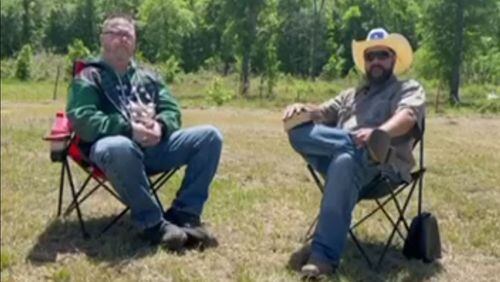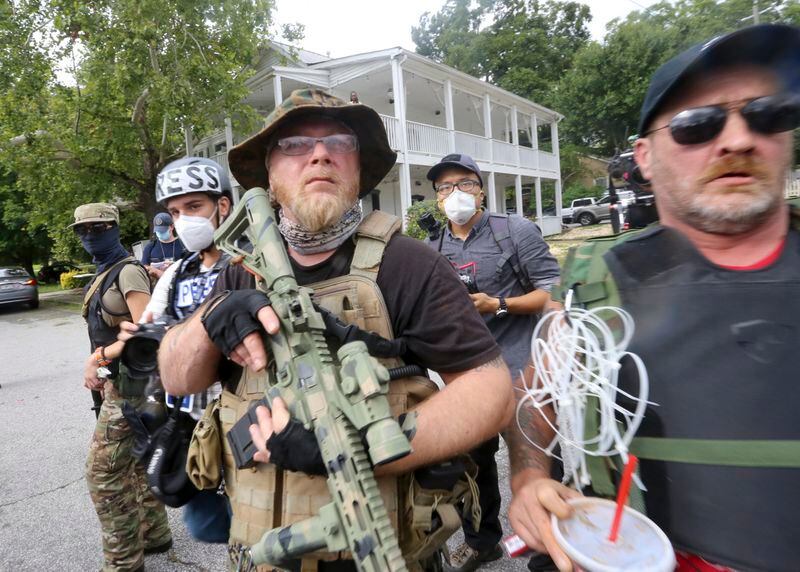In a video published online last month, Georgia militia leader Chris Hill and Eric Braden of the Texas-based Southern Patriot Council discussed the overthrow of the United States government, by violence if necessary.
“It’s all or nothing,” Hill said. “Revolution is at hand.”
It’s not clear who heard the call. The video was published on the Toronto-based video sharing site Rumble where it garnered just a few dozen views. Hill also promoted it on Gab, a social media site popular with some far-right figures, but only 27 people follow his account there.
It’s a precipitous fall from a year ago when Hill had a Facebook account with tens of thousands of followers, along with a separate, private Facebook group where he and members of his III% Security Force militia could meet in relative secrecy.
Social media bans by Facebook, Twitter and YouTube have dramatically reduced the reach of extreme right figures like Hill, disrupting their ability to plan and recruit new members, according to experts who monitor domestic extremism.
Social media purges of accounts and groups began in earnest last summer in response to a wave of extremist-linked content during the pandemic, especially accounts linked to the wide-ranging conspiracy theory known as QAnon. Alex Friedfeld, a researcher with the Antidefamation League’s Center on Extremism, said social media giants targeted them again after the Jan. 6 insurrection at the U.S. Capitol.
“They are struggling,” Friedfeld said of militia groups. “One of the big reason is the de-platforming that happened after the insurrection.”
Friedfeld said the Hill video reflects the broader sense of anger as the militia movement has come to shoulder much of the blame for the Capitol insurrection.
“They feel like they are under attack. They are feeling the pressure,” he said. “For the first time in long time ordinary people are aware of the movement and there is a stigma to it.”
That disapproval, combined with widespread bans, has been destabilizing for militias across the nation, he said. The 18-minute video of the two men sitting in camping chairs in a grassy field is decidedly low-tech. At one point, the camera toppled over and had to be reset.
Branden tried to spin the de-platforming as having a unifying effect as the far right has fled to other platforms, but Hill was not optimistic.
“They have completely silenced me. They don’t want any opposition,” he said.
Hill listed federal authorities, the media and “the left” as the culprits behind the current disarray in the militia movement, which he said has been “absolutely silent” since the Jan. 6 assault on the U.S. Capitol.
Bans curb reach, experts say
Hampton Stall, a researcher with the Armed Conflict Location & Event Data Project, which monitors political violence across the globe, said there is a definite connection between the deplatforming of extremist groups on social media and their dwindling activity, especially since Jan. 6.
According ACLED data, Hill’s militia group has dramatically decreased its “real world” activity in the past six months.
“I think different leaders are taking it differently. Chris Hill is probably the most publicly frustrated,” Stall said. “I have seen a lot of militia leaders who have said they are done, it’s not worth it anymore.”
The most recent training exercise for Hill’s militia was in April, after which Hill posted a 1-minute video of himself drinking a beer and firing a 50-caliber rifle. The video had 10 views.
Stall said the training drew about a dozen people and had to reach into surrounding states even for that. And Hill’s organization has been further hampered by internal strife.
Stall said a sizable portion of Hill’s militia split off earlier this year to form an independent group. It’s not the first such schism, but Hill’s core group is very small now, he said.
“I’m not sure how they are going to weather it,” he said.
Fewer places to hide
After the Jan. 6 insurrection, militias are finding it harder to stay under the radar of mainstream social media companies.
“People now know what the symbol means,” Stall said, referring to the three percenters’ use of Roman numerals and the percent sign as a signifier. “When your local sheriff changes his Facebook banner to a three percent symbol, people recognize it and report it to local media.”
Mary McCord, a former U.S. Department of Justice official who now heads the Institute for Constitutional Advocacy and Protection at Georgetown University’s law school, said the flight by extremists to other platforms like Gab and Telegram mean they reach fewer people.
“There’s just a higher barrier of entry to use those other forums,” she said.
But, she said, “I still see the threat as very significant.”
Credit: TNS
Credit: TNS
Long before the Jan. 6 uprising, McCord had been calling on states to use existing laws to curb militia activities. A law in Georgia dating back to the 1950s prohibits groups from forming “themselves together as a military unit or parade or demonstrate in public with firearms,” but it has not been applied to counter private militias.
That lack of enforcement encourages what McCord described as an “insurrectionist view of the Second Amendment” espoused by Hill in the video.
“It’s spreads this false narrative that this is not only protected activity but also encouraged,” she said.
Rhetoric still poses danger
Watchdogs warned social media companies for years that their algorithms designed to feed users content they enjoyed were funneling far-right extremists and conspiracy theories toward each other, further radicalizing some and allowing others to recruit and organize.
Last year, companies like Facebook and Twitter — and, to a lesser extent, Google — got serious about purging or downgrading extremist accounts.
Some conservatives called the bans censorship. The purges drew harsh criticism from conservative leaders in Congress loyal to former President Donald Trump after he was booted from both Facebook and Twitter.
However, a recent report from the Digital Citizens Alliance and Coalition for a Safer Web claims that social media companies still aren’t doing enough to root out extremists on their pages.
The report says domestic extremists have adopted the tactics of Islamic radicals abroad, foiling artificial intelligence filters by using seemingly innocuous terms and hashtags. Whereas ISIS used “Allahu Akbar,” a centuries-old Muslim greeting that means “God is great,” as a hashtag to carry their message, domestic extremists have adopted positive ideas, like #patriotsincharge and #savethechildren, to reach out to like-minded people and avoid existing bans.
While social media bans have curbed the reach of figures like Hill, Friedfeld said Hill’s calls to take up arms against the government are still dangerous.
“If the (Capitol) insurrection taught us anything, it’s you have to take these guys at their word,” he said.
Friedfeld said Hill’s modest social media reach doesn’t mean his rhetoric isn’t dangerous. Those who seek him out are true believers who are listening for instructions and may feel pressured to take action.
“He’s the head of an organization and people are watching him,” he said.
Our reporting
AJC investigative reporter Chris Joyner covers extremism for the AJC. He has written extensively about extremist factions in Georgia on both the right and the left, and about Georgians who participated and were arrested for storming the U.S. Capitol on Jan. 6.
About the Author








